27 February, 2002
GOOD-BYE TO PALMER STATION!
The Laurence M. Gould is scheduled to depart from Palmer
Station today. On board will be a team of scientists who have been out in
the Southern Ocean on a GLOBEC cruise. They are coming back to Palmer
Station to pick up the eight scientists and support personnel who are
returning to Punta Arenas. I will be one of them.
It makes it easier to leave when I think about all the other people who have
come and gone from Antarctica before me. One of the interesting things
about Antarctica is the history of the continent. There have been three
vivid reminders of that history while I have been here.
First, in January we had a visit from HMS Endurance, the British ship doing
hydrographic work in the area. Many residents of Palmer Station were
invited out to the ship (see journal of January 17th). Endurance is named
after the ship of the same name, captained by Sir Ernest Shackleton on his
voyages of exploration to Antarctica. Hanging in the wardroom of the
Endurance is a framed photograph said to be the personal property of Sir
Ernest Shackleton. It is entitled "St. Paul's from the Thames", dated 1886.
The photograph is said to have been with Shackleton on all his voyages to
Antarctica. It was aboard the Endurance (and saved by Shackleton) when the
ship was crushed by the ice in 1915. The photograph was given to HMS
Endurance by the Shackleton family. A granddaughter of Sir Ernest
Shackleton is the patron of the ship.
We had another interesting glimpse of history with the visit of one of the
tour ships. One of the experts on board the ship, lecturing in the history
of the area, was John B. Killingbeck of England. Mr. Killingbeck worked
with the Faulkland Islands Dependency Survey from 1960-1963. They surveyed
a great deal of the Antarctic Peninsula, using dogsled teams to transport
themselves out into the field. They would camp and survey for two to three
months at a time. The surveyors went out in teams of two men. Each man had
a sled and nine dogs.
Mr. Killingbeck was invited back to the Antarctic Peninsula in 1994, when
the last fifteen dogs in Antarctica left from the British base Rothera. The
dogs, descendents of the earlier dogs used in Antarctica, were leaving as a
condition of the Antarctic Treaty, because dogs are not native to
Antarctica. Mr. Killingbeck and his partner worked with the dogs on a last
surveying expedition on the Antarctic Peninsula. Then they accompanied the
dogs on their journey via airplane to the Faukland Islands, from there to
London, and then on to Boston. Once in North America, the men and the dogs
went by truck and sledge to an Inuit village in Canada. The dogs' ancestors
had come from there originally.
The third reminder of Antarctic history is right next to my bedroom. It is
the back stairwell of the GWR building. Hanging there are 36 group photos
of the people (and in the early days, the dogs) that wintered over at Palmer
Station. The earliest photo is from 1965. The most recent photo is that of
the group that was here for the winter season (approximately March-October)
in 2000. It is a great reminder of the people who have been to Palmer. Most
of them probably left with mixed emotions, as do I!
Good-bye, Palmer Station!!
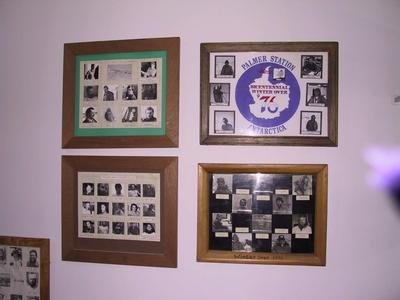
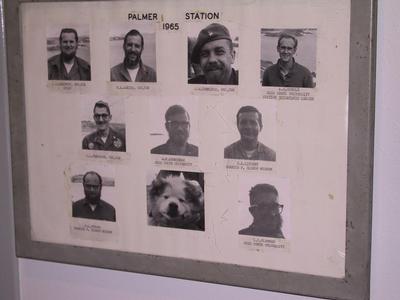
This photo of the 1965 group is the earliest photo in the gallery.

This is the framed photograph, "St. Paul's from the Thames", hanging in the wardroom of HMS Endurance.
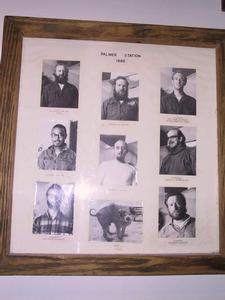
This photo of the 1966 "winter over" team has a dog in the group, as well. The dog is Eddie. This group lived at what we now call the "Old Palmer" site, which isn't too far away from here by Zodiac.

This stairwell in GWR contains the gallery of photographs of groups "wintering over" at Palmer Station.
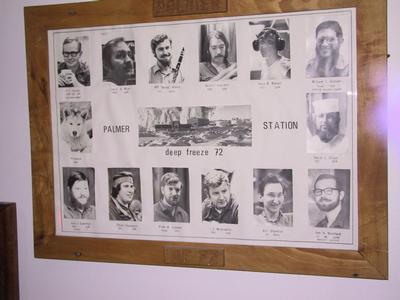
This photo, from 1972, includes a photo of a dog as a member of the group. The dog is Princesa. This group lived at our current site. It was built between 1967-1970, and occupied in 1970.
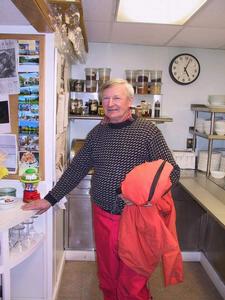
Mr. John Killingbeck, the British surveyor and dog-hander on the Antarctic Peninsula in the 1960's. Mr. Killingbeck is standing in the Palmer Station galley.
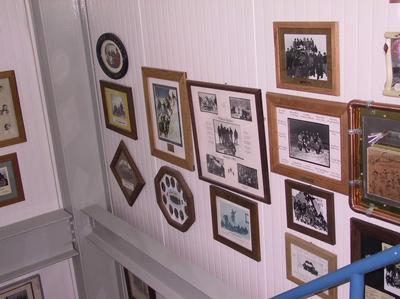
Another view of the gallery.
Contact the TEA in the field at
.
If you cannot connect through your browser, copy the
TEA's e-mail address in the "To:" line of
your favorite e-mail package.
|
